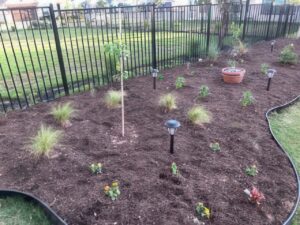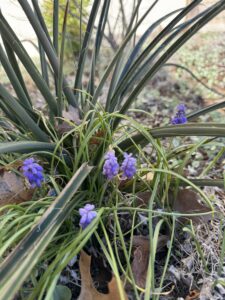How to fill raised beds and containers
Let’s start with Step 1. In order determine the volume of material you need begin by measuring your garden bed. I can use the graph plan for the length and width leaving the height as a variable decision.
The simple calculation needed to determine how much of any fill you need is to multiply the length of space by the width of the space. Take the total and multiply by the height of the required space. Length x width x height = cubic amount of required material.
This principle works in empirical measurements as well as metric measurements. It also applies to in-ground beds, raised garden beds and containers using the appropriate measuring units. Cubic feet for containers and cubic yards usually for in-ground applications. Raised beds may fall into either category according to size.
For example: I want to plant a new perennial salvia bed. I know the length of the bed is 8 feet and the width will be 3.5 feet. My ground is on a rocky outcropping so I am going to top this area with 6 inches (1/2 foot) of fill to make the calculations easier.
8 feet x3.5 feet x.5 foot is equal to 14 cubic feet or just about 1/2 cubic yard. A cubic yard is equal to 27 cubic feet.
How about a raised vegetable bed that is 4 ft. x 4 ft. x 1 ft. This is around an average raised bed. You are going to need to fill with 16 cubic feet (.59 cubic yard) of mix.
I actually have a container which takes exactly 1 cubic foot of soil being 1 ft x 1ft x1 ft in size. So cute but you would be surprised what that size allows you to grow. Like herbs, rosemary comes to mind because I tend to overwater it in the ground. Just for reference a 1/2 whiskey or wine barrel commonly used in gardens takes in the neighborhood of 4 cubic feet of planting mix.
Step 2 is sourcing the fill material. Here I’m going to begin with the container gardening. These take potting mix which is beneficial for plants growing in containers and can be sourced from a of variety gardening suppliers in your area. Really try to get the best you can afford which is appropriate for the plant you desire to grow. Read the bag volume units. These mixes come in quarts, 1,1.5, and 2 cubic foot increments usually. I made the mistake of purchasing a tiny bag thinking it was 1 cubic foot and was so delighted with the price I paid until I started filling my container. Not so delighted when the soil only came a part of the way to the top of the container.
What I do today is decide what I’m willing to pay. Then I think of the product that is most attractive to me (mostly something organic) and price check my area. Make sure to contrast the same sizes bag from each source. Say this product is too high all over, then go to your second choice and so forth trying to stay near your budget amount. I may spend between $12.99 and $19.99 per 2 cubic feet of premium potting soil.
When we move to filling the larger raised beds and in-ground choices I know the landscapers in your area offer the best cost effective bulk option. Use the above calculations to gauge how much you will order. Be prepared because they deliver a huge heap all at once. Each company will have minimum amount requirements before delivering as well. We did that in the beginning but it is more our style to use a bagged product and move the dirt a little at a time. Your access to a convenient place to dump all the fill needs to be a consideration.
Let’s look at 1 cubic yard. I sourced a garden blend in my region that I have had excellent success with before. The price per cubic yard is $145.00 and the delivery fee adds $60.00 to the total which comes to $205.00 + tax. I wouldn’t need to add anything to the soil for a couple of years so there is some savings. We can just about fill two of the above sample beds (both in-ground and raised garden beds) for this amount.
Now, I may be able to find my luxury bagged mix at 2 cubic feet for $19.99 each. We would need basically 14 bags to equal 1 cubic yard. Just a bit more actually and we could haul them home ourselves. The amount for this will come out to $280.00 + tax. I may need to add amendments to the mix next year but its usually a dump and go practice well suited to the raised garden bed category. I know that using a bagged soil or potting mix will generally need topping up the nest year because everything settles over time.
What if you get the urge to mix your own? I have to admit; I would love to try this option. I can give you some resources in the reference area to read up on but haven’t gone there yet. Square Foot Gardening teaches how to use Mel’s Mix and I understand many gardeners have found it very worthwhile. I’ll circle back and keep you posted on my experiences of making my own mix.
Jeff tends to enjoy in-ground gardening and I have found many positive outcomes using this method. I am surprised at the amount of growth on plants just a few years old growing in-ground. Quite natural and beautiful to use this method and for things I am not going to fiddle with as often like perennials it is the best. I do enjoy my raised beds for bringing the garden up close. I don’t need to bend as much and picking veggies is way more exciting when you can grow them where peeking under the leaves is easier.
I hope you find this information useful in planning your garden and it becomes a very happy space in your life.
Gregg’s blue mistflower newest Texas Superstar
As we discussed on the podcast, the Gregg’s blue mistflower has been named a Texas Superstar plant! You can get all the details of this super heat loving flower here:
Resources.
1. “Raised Bed Revolution; Build It, Fill It, Plant It, Garden Anywhere”. Author: Tara Nolan. 2016 pgs. 66-67
- Online: squarefootgardening.org. Mel’s Mix Resources.
- Rodale’s Successful Organic Gardening; Improving The Soil. Author: Erin Hynes 1994
- Online: BuildaSoil.com. “Build a soil from scratch with 3 proven recipes.”
- Online: Texas A&M AgriLife Today ; Gregg’s blue mistflower newest Texas Superstar, Author: Adam Russell. August 21,2024
“To plant a garden is to believe in tomorrow” —Audrey Hepburn







